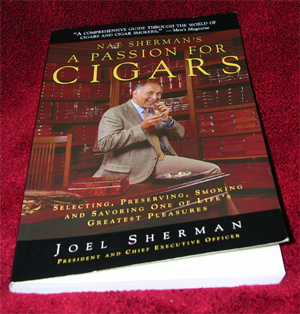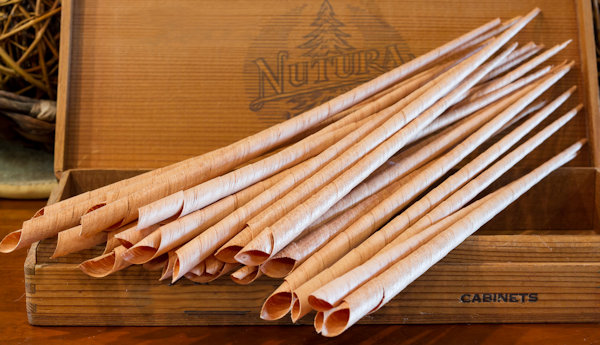 On a blistering hot Sunday afternoon I felt like having a drink and a cigar to pass the time. On my way out the door I picked up my copy of Nat Sherman’s: A Passion for Cigars and made my way out into the front yard. I made myself comfortable in the shade of a Walnut tree and started my peaceful afternoon.
On a blistering hot Sunday afternoon I felt like having a drink and a cigar to pass the time. On my way out the door I picked up my copy of Nat Sherman’s: A Passion for Cigars and made my way out into the front yard. I made myself comfortable in the shade of a Walnut tree and started my peaceful afternoon.
A Passion For Cigars was published in 1996 by Andrews McMeel Publishing. The book is written by Joel Sherman, the son, as well as the President and Chief Executive Officer of Nat Sherman Incorporated.
Introduction:
The book starts off with a very friendly attitude, almost as if the author is sitting down with the reader and explaining to them that they are thier own cigar expert. He goes on to explain how regardless of his feelings for a particular cigar, you may or may not feel the same way. As a result the book is designed to be a handy reference along your journey into cigars rather than a detailed map of the path.
Chapter 1:
Chapter one starts off in the most logical of places, the beginning. Very interesting information about the history of cigars is shared. As time passes Joel Sherman shares with us the journey of tobacco from early Mayan times to the times of the Clinton Presidency.
Chapter 2:
As I progressed further along with my literature and cigar, I began to learn about how tobacco is grown as well as how it is used to form cigars. The author takes us through the growing process and explains how different diseases can effect the entire crop of tobacco.
Included are photos of the full grown tobacco plant with designations to help identify the Ligero, Seco, and Volado. After explaining how the plant is grown and primed, we then learn the process of bunching and rolling. Several photographs are dedicated to the single act of rolling on the wrapper leaf and show the step by step process.
Chapter 3:
After reading seventy pages I found myself immersed in the third chapter of A Passion For Cigars. This chapter takes us through the process of properly selecting a cigar which will appeal to us as a new smoker. At this point in the book I began to second guess some of the authors opinions.
Page 76
… An important rule of thumb is that the wider the ring gauge, the fuller the flavor of the cigar. If you prefer a lighter smoke, start with a smaller ring gauge. If you’re in the mood for a full-bodied, robust, intensely flavored cigar, try one with a wide ring gauge.
While this may have been true at the time the book was written, it is bad advise for the new smoker getting into the hobby at this point in time. There are dozens upon dozens of cigars that are just the opposite of this statement.
Page 77
… Or you can try and fit the cigar to the smoker’s personality-larger for the extroverted; smaller for the shy-and size-wide for the stouter person; longer and thinner for the taller and lankier.
Statement like these, in my opinion, are why there are so many misconceptions about the cigar smoking hobby.
After learning how to properly select my cigar I am educated on determining a cigars flavor intensity based on wrapper color.
Page 92
…And just as different sizes provide different flavors-the rule of thumb being that the wider the ring gauge, the more powerfully flavored the cigar-different-color wrappers will provide clues as to how a cigar will taste. the lighter colors generally deliver a lighter flavor. Some smokers with a wide range of preferences find the mellow wrappers preferable at certain times of the day and the heavier, darker-colored wrappers better at others.
Again, this statement may have been spot on at the time this book was written but is now a bad example of flavor based off of color. For example, which has the richer flavor, the darker Helix Maduro or a lighter Opus X?
Page 107
Because it would be outrageously expensive to grow maduro tobacco in the field, all maduro now on the market is made from the ripest leaves and have been either steamed or boiled until they’re the dark brown color that makes a maduro cigar.
Honestly, I am not up to date on the current process of creating a Maduro wrapper. However I believe that the author makes an excellent point in regards to this type of wrapper in the 1990’s. He gives us a glimpse at just how desperate cigar manufacturers were to quickly produce a product that was in such high demand.
Chapter 4:
After learning how to properly determine which cigar may, or may not, suit our tastes the author progresses into the topic of Humidors and Accessories. In this chapter we learn how to properly care for our cigars with the use of a humidor. There is even a simple how-to on building a humidor using house hold products to maintain humidity. An interesting topic covered in the book is how different packing stiles have potentially different optimal relative humidity levels.
Once I have learned to properly store and inspect my cigar the author explains the lighting process. During this time I read one of my biggest pet peevs and literally began to shake my head in disappointment.
Page 126
… before lighting the end, or “tuck” as it’s called, run the flame up and down the length of the cigar a few times. This gets the tobacco oils flowing.
After this terrible word of advise, the author does an excellent job on explaining how to light a cigar properly. Great care is taken to explain why it is important not to touch the flame of the lighter to the tobacco or why the use of candles or sulfur matches is a bad idea.
Chapters 5:
Once we have learned how to select, store, light, and enjoy a fine cigar the author broadens our horizons on the topic of the cigar Dinner. Different menus are broken down and explained so that we can easily see why one type of cigar may go well with a particular type of food.
Two menus, as well as recipes, are broken down so that we can easily host a dinner in our own home.
Chapter 6
As the book comes to a close, a list of respected retailers and listed. The listing is broken down by state and also contains a few retailers outside of the US.
Overall Opinion:
In a nutshell I think that this book was an interesting read and most definitely educated me on some of the finer points of cigars. In addition to some of the quotes above, I found several other topics which I disagreed on. With some of the advise shared in this book I would not feel comfortable recommending it to a new smoker. I feel that some of the advise needs to be ignored and a new smoker would not know which words of wisdom to take to heart, and which ones to pass over.
If you have been smoking for some time now, or have spent some time reading the wealth of knowledge available on the many Cigar Forums, this book may be an interesting read for you. There is most definitely some interesting points of view contained within its pages. Just be aware that not all of it is up to date and a good idea for a smoker in this period of time.
is available at Amazon.com





I’m a fan of cigar books and have quite a few, but not this one. You’re absolutely right about keeping historical context in mind. Times have definitely changed, and for the better!
One of my favorite books of cigar lore is “Holy Smoke” by Guillermo Cabrera Infante — it’s more of a literary rhapsody than a “how-to” book like this one, but he lived at a time when it was okay to store cigars in the refrigerator. You certainly wouldn’t want to do that today.
Thanks for the review!
Once again an excellent review Walt. I don’t have any books at this time concerning cigars but have been looking for a good one to pick up. Do you have any other recomendations?
Thanks,
Bugs
Bugs,
I read The Complete Idiots Guide to Cigars a while back. I thought it as a good read. It was a nice refresher with alot of things in it that I wasn’t aware of.
I’m in the process of reading The Connoissuer’s Book of the Cigar by Zino Davidoff. That review is next in line for book reviews. So far I am enjoying it, but being translated in 1969 makes for alot of outdated information. I’ll get into that more in the review.
-Walt